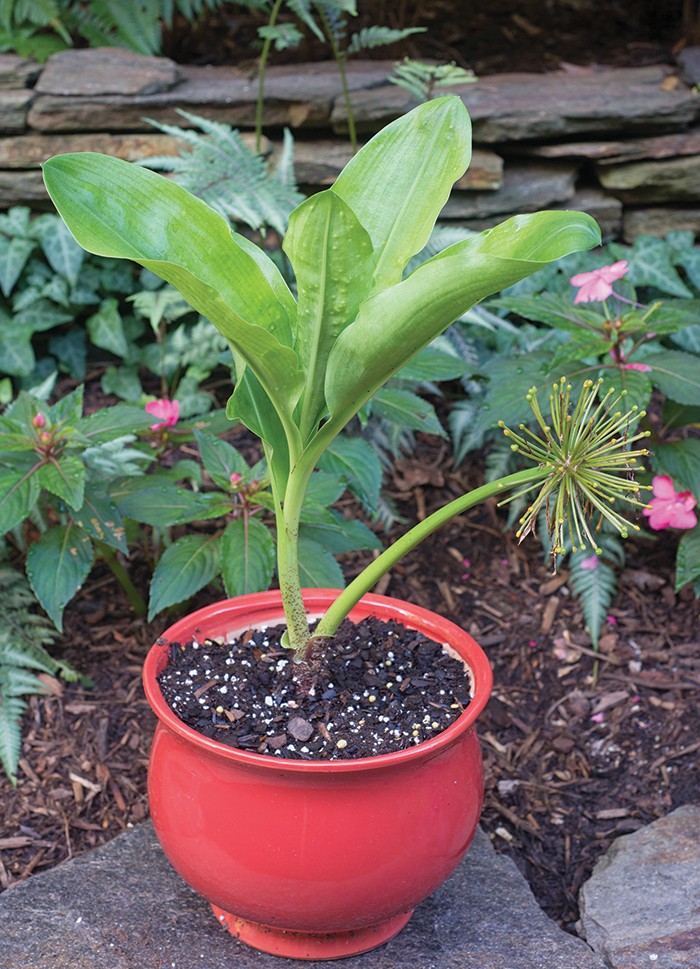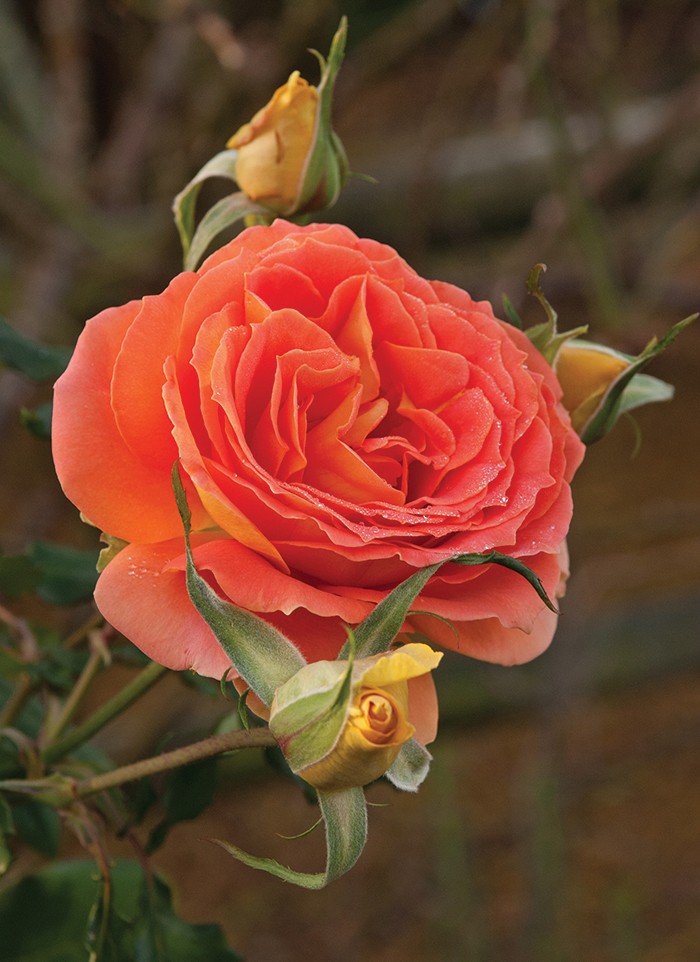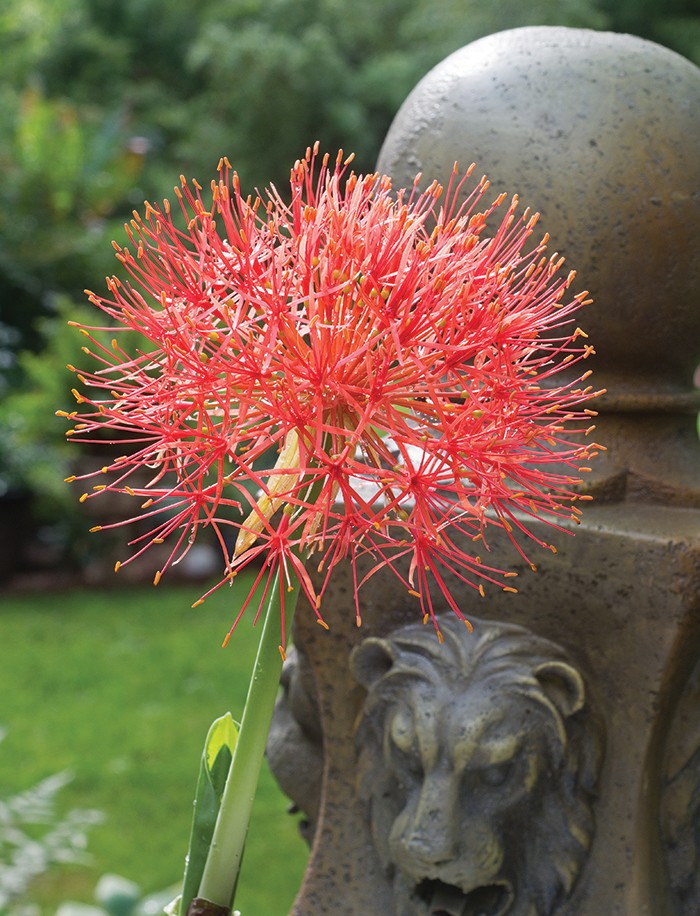If you like to garden and gamble, do I have a plant for you! It’s called scadoxus, which, I am sure for many, draws a blank. Allow me to enlighten. Scadoxus multiflorus, also appropriately called “Fireball Lily,” “Torch Lily” or “Blood Lily,” is a South African import that’s not a true lily, but rather is from the amaryllis family — a fact that might be worth a small wager or two.
When planted after the last spring frost date — it is a tender beauty — a scadoxus bulb remains restrained until early summer. Then, a strong stem suddenly sprouts up to about a foot high, bearing a large, royal crimson blossom shaped like — and the size of — a softball.

Scadoxus in full foliage flaunt
Upon seeing this flashy display, an uninitiated gardener might think, “It’s red spider lily — Lycorus radiata!” Here’s where you can make money. Sure, the blossom is a single tight cluster of bristling micro-flowers dipped in sizzling scarlet, meaning it’s similar looking to the widely grown red spider lily, but it is larger, more rounded and blooms sooner. Start taking bets.
This bold blossom will last for a week or two, and then its beautiful blaze will slowly fade away. However, there is a second act. A leaf stalk will quickly rise 12 to 18 inches from the bulb’s base, almost rudely pushing the spent flower tower to the side. Its unfolding large leaves, paddle shaped and gleaming green, resemble the foliage of the popular fiddleleaf fig (Ficus lyrata) houseplant. Fiddleleaf! Who wants to wager it’s a young fiddleleaf fig?
Cold, wet winters outdoors could put the bite on this bulb, so it’s not a bad idea to grow scadoxus in the Cary area as a potted pretty in partial sunlight. Two more reasons to keep it contained: It needs good drainage and seems to flower better when its roots are crowded.
Bring scadoxus inside before nighttime temperatures fall below 50 degrees. Cut way back on water, and allow the foliage to slowly die down. The bulb will then recharge through the winter and be ready for more bets late next spring.
Since scadoxus waits until temperatures turn balmy to begin growing, now is not the time to plant, but rather the time to find. Call around to see if any of your local friendly garden centers have it in stock. I know Plant Delights Nursery in Raleigh sells it online at plantdelights.com and at their open nursery weekends. Brent and Becky’s Bulbs in Gloucester, Va., also offers it, at brentandbeckysbulbs.com.

‘Brass Band’ rose
Replace the mulch around your roses late this month. Swapping out winter mulch with a new, fresh, fluffy ground covering applied to a thickness of 2 to 4 inches will help keep roots cool during the summer, prevent weeds and retain soil moisture.
Since most mulches have little nutritional value for rose plants, go with a one-two approach by first generously spreading rich compost and then topping it with a typical, more eye-appealing layer of shredded hardwood, pine straw or pine bark.
Why not just leave the ol’ stuff in place? It could be harboring the overwintering, soil-borne, nasty known as black spot or other fungal diseases. So, rake it, bag it and toss it away.
To Do in the Garden
March
- Not all plant beds need to be mulched now. In particular, wait until at least May before mulching areas set aside for summer annuals so the strengthening spring sun can warm the exposed soil to a balmy enough temperature for stimulating rapid root growth.
- Would you like more herbal helpers this growing season? Now is a good time to divide such perennial favorites as chives, mint, tarragon and creeping thyme.
- It is not too soon to start a vegetable garden. The first two weeks of March, plant hardy edibles such as potatoes, spinach, onions, lettuce, kale, radishes and mustard greens that can take the chill of a fading winter. At the end of this month, broccoli, cauliflower, Chinese cabbage and beets can be added to the veggie patch.
- Want years and years of dependable service from your lawn mower? One of the most important maintenance chores you can do to keep your grass muncher running longer is to change the engine’s oil at least every two years.
- With activity from your feathered friends on the wing picking up now, welcome birds back into your garden by thoroughly cleaning out the bird bath and start adding fresh water to it at least once a week. Also, check bird feeders for any wet, moldy or gunky seed and clean it out.
- Act Naturally
- Act Naturally
- Mr. Cary Spirit
- The Not-So-Secret Sarah P. Duke Garden
- Nonprofit Spotlight: White Oak Foundation
- Best of Both Worlds
- Small Business Spotlight: The Flower Cupboard
- From the Editor: March 2020
- Alex & Teresa’s Pizzeria & Trattoria
- Worth the Drive: A Fresh Look at Calabash Seafood
- Liquid Assets: Spring Bock by Carolina Brewing Company
- Liquid Assets: Raymond Fairchild Root Beer White Lightning
- Garden Adventurer: Scadoxus, for the Gambling Gardener







